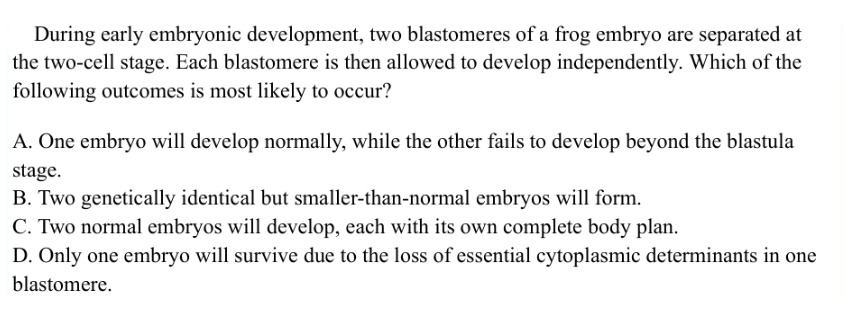Question
Question: During early embryonic development, two blastomeres of a frog embryo are separated at the two-cell s...
During early embryonic development, two blastomeres of a frog embryo are separated at the two-cell stage. Each blastomere is then allowed to develop independently. Which of the following outcomes is most likely to occur?

One embryo will develop normally, while the other fails to develop beyond the blastula stage.
Two genetically identical but smaller-than-normal embryos will form.
Two normal embryos will develop, each with its own complete body plan.
Only one embryo will survive due to the loss of essential cytoplasmic determinants in one blastomere.
Two normal embryos will develop, each with its own complete body plan.
Solution
During early embryonic development, the process of cleavage divides the zygote into blastomeres. In organisms with indeterminate cleavage, such as frogs, the fate of the blastomeres is not fixed at the early stages. Each blastomere retains the potential to develop into a complete organism. This is in contrast to determinate cleavage, where the fate of blastomeres is determined early, and separating them would result in incomplete embryos.
Frogs exhibit radial, indeterminate cleavage. At the two-cell stage, the two blastomeres are totipotent or highly pluripotent. If these two blastomeres are separated and cultured independently, each blastomere is capable of developing into a complete embryo. Since both blastomeres originate from the same zygote through mitosis, the resulting embryos will be genetically identical, forming identical twins.
While these embryos develop from half the initial cellular mass, they regulate their development to form a complete body plan. They might be smaller initially compared to an embryo developed from an undivided zygote, but they are typically viable and develop into normal larvae and adults, albeit sometimes smaller.
The ability of each blastomere to form a complete organism is the primary biological principle demonstrated by this experiment. Therefore, the formation of two complete embryos with their own body plans, is the most likely intended answer that best describes the fundamental outcome.
